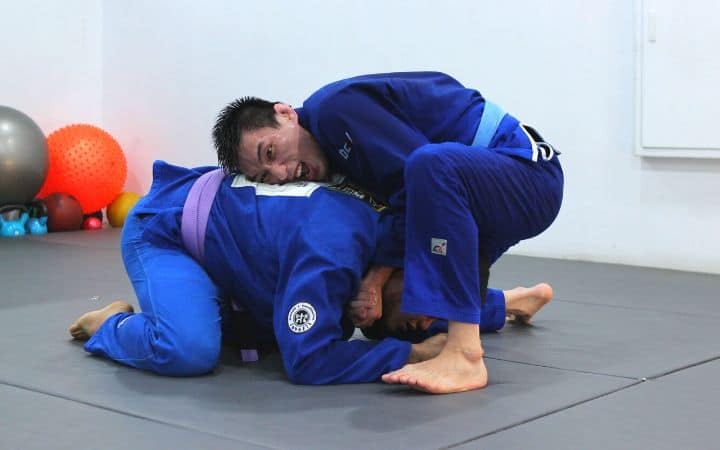The Peruvian necktie – Origins and Etymology
The Peruvian necktie is one of the most useful chokes you can have in your BJJ arsenal. It is one of those moves that you can set up seemingly out of the blue, and catch pretty much everyone with it. The man we owe for this sneaky submission is Tony De Souza, a Peruvian born UFC vet and BJJ black belt.

How to do Peruvian necktie?
The Peruvian necktie is a choke from the front headlock position. This position is important in wrestling, but it is not as utilized in Jiu Jitsu. The front headlock works when you are in front of an opponent who is bent down and you have their head and one arm trapped in a headlock.
In Brazilian Jiu-Jitsu terms, the best time to go for a front headlock, and everything coming out of it, is when an opponent goes to the turtle position. While most people like to head for the back, if you opt for the headlock instead, you’ll have plenty of submission options, the Peruvian necktie being the sneakiest of them all.
The Peruvian necktie is essentially an arm triangle. On one side, it is the shoulder of the opponent’s trapped arm blocking one artery on the neck. On the other, it is the forearm of your opposite arm. Both your arms should be clasped firmly under your opponent’s chin. However, it is not the grip and squeeze that make the Peruvian necktie work – it is the angle of the choke.
There are many ways to link your hands together for a Peruvian necktie, but the most utilized is an S-grip. That is when you place the tops of the fingers of both hands together making interlocking “hooks.”
To finish the necktie, you’ll have to sit on the ground to the side of the trapped arm. This way, you get a great angle to throw a leg over the head, which is absolutely essential for the choke.
A black belt tip I got, given my bad knees, was not to sit down directly, though. Instead, I was advised to get my head as near to my opponent’s hips as possible and then sit down. This provides a great angle for the choke and makes swinging the leg much easier and more knee-friendly.

How to defend the Peruvian necktie?
Defending the Peruvian necktie can be tricky against experienced front headlock players. The one mistake most people make when defending the Peruvian necktie is focusing on the grips. That is the hardest part of the entire structure to break. Instead, defeating the angle is the key to escape. The angle makes or breaks the Peruvian necktie!
To defend the Peruvian necktie, your main goal is to cut the angle before your opponent manages to sit down. As they move to do so, you need to fall to the side of your trapped arm. The motion is very easy – it is simply a wrestling sit out. Simply extend your inside leg across the mats and your body will follow. You’ll most likely end up in bottom side control, but there will be no choke.
Keep in mind that the simpler the defense, the better. The Peruvian necktie pairs with a bunch of other chokes like the D’arce, Anaconda, Guillotine, Japanese necktie and others. The goal is to get out as soon as possible because staying in the front headlock will get you choked.

Peruvian necktie instructional videos
In order to get a better understanding of the choke, check out a few videos on the Peruvian necktie. In them, you’ll find visual cues for all the details explained earlier and more options in terms of setups and follow-ups.
In this video, you can see the basic Peruvian necktie being performed, as well as a variation that uses the Gi lapel on one side. Moreover, there are details on the S-grip, and how to hold it, at the beginning of the video.
Here, you can see how the Peruvian necktie ties in perfectly with the Japanese necktie to form a loop that is extremely hard to escape from. If you’re too late with the second leg and an opponent rolls over, you always have the option of attacking with the Japanese necktie without having to adjust your arms.
Professor Pedro Sauer is a coral belt and one of the few people you can trust to understand the complexities of escaping the Peruvian necktie. Pedro Sauer emphasizes the crucial detail of focusing on the angle, and he explains it to the tiniest detail in this video.
Summary
The Peruvian necktie works. It offers a whole new perspective from the front headlock and will help you tap opponents when they think they’re safe. It is not hard to pull off but does require a bit of getting used to: mostly to get the correct angle. Moreover, if you’re getting tapped with it all the time, learning how to do it will help you discover the exact moment to neutralize this powerful BJJ choke. Have fun!

We care about Jiu Jitsu so much that we decided to create this page for all the people like us – that eat, breath and live the Jiu Jitsu Lifestyle! We truly hope our content will make every one of your days better, on the mat and off the mat!
